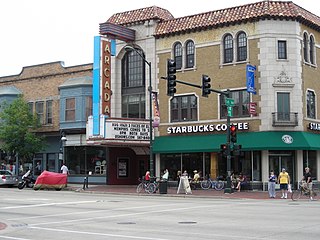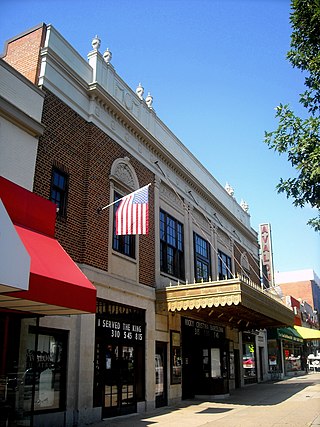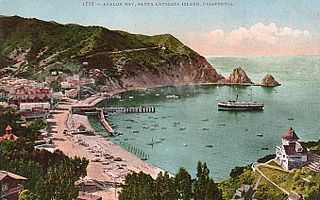Avalon is an island in the Arthurian legend.
Palace Theatre, or Palace Theater, is the name of many theatres in different countries, including:
Strand Theatre or Strand Theater may refer to:

The Loew's Jersey Theatre is a theater in Jersey City, New Jersey. Opened in 1929, it was one of the five Loew's Wonder Theatres, a series of flagship Loew's movie palaces in the New York City area. It was designed by the architectural firm of Rapp and Rapp in a Baroque/Rococo style. Tri-plexed in 1974, and then closed in 1986, it was dark for years. It was purchased by the city in 1993 and has been operated by a volunteer organization, the Friends of the Loews, since that time. The theater was designated as a New Jersey Registered Historic Site in 2009. In a move opposed by Friends of the Loews, the city in June 2014, agreed to let AEG Live operate the venue. After going to court, the lease by Friends of the Loews remains in effect. In 2022, a $72 million restoration project was started by Devils Arena Entertainment, a division of Harris Blitzer Sports & Entertainment that operates the Prudential Center, with completion being expected by 2025.
Star Theatre(s) or Star Theater(s) may refer to several cinemas or theatres, including:
Paramount Theater or Paramount Theatre may refer to:

The Catalina Casino is a large gathering facility located in Avalon on Santa Catalina Island, off the coast of Los Angeles in California. It is the largest building on the island and the most visible landmark in Avalon Bay when approaching the island from the mainland.

John Adolph Emil Eberson was an Austrian-American architect best known for the development and promotion of movie palace designs in the atmospheric theatre style. He designed over 500 theatres in his lifetime, earning the nickname "Opera House John". His most notable surviving theatres in the United States include the Tampa Theatre (1926), Palace Theatre Marion (1928), Palace Theatre Louisville (1928), Majestic Theatre (1929), Akron Civic Theatre (1929) and Paramount Theatre (1929). Remaining international examples in the atmospheric style include both the Capitol Theatre (1928) and State Theatre (1929) in Sydney, Australia, The Forum, the Lewis J. Warner Memorial Theater (1932) at Worcester Academy in Worcester, Massachusetts and Le Grand Rex.

The Aztec Theatre is a historic theater in downtown San Antonio, Texas, United States.

The Arcada Theatre Building is a theater in St. Charles, Illinois located on Main Street. The theatre was opened on Labor Day, September 6, 1926, engaging projection of silent movies and the staging of live vaudeville acts. Except for brief periods of renovation, it has remained continuously open. It is listed on the National Register of Historic Places.

SS Catalina, also known as The Great White Steamer, was a 301-foot steamship built in 1924 that provided passenger service on the 26-mile passage between Los Angeles and Santa Catalina Island from 1924 to 1975. According to the Steamship Historical Society of America, Catalina has carried more passengers than any other vessel anywhere. From August 25, 1942, until April 22, 1946, the ship served as the Army troop ferry U.S. Army FS-99 at the San Francisco Port of Embarkation transporting more than 800,000 troops and other military personnel between embarkation camps and the departure piers. After a period of service as a floating discothèque, the ship ran aground on a sandbar in Ensenada Harbor in 1997 and partially sank on the spot. It was scrapped in 2009.
The Liberty Theatre is a former Broadway theatre in New York City.

The Avalon Theater is a Historic Art Deco style Movie theater located in the commercial district of Larimore, North Dakota, United States. Built in 1938 as a 350-seat theater, the Avalon's most significant feature is its Art Deco detailing, especially the marquee, box office, and entry doors and continuing with simple Art Deco geometry motifs in the interior, all of which has survived. The building is constructed of brick with a parabolic poured concrete floor in the seating area to ensure a good view for all. The building still functions as a movie theater, with its original projectors, and also is home to local live theater groups.
Arcade Theater may refer to:
Center Theater or Center Theatre may refer to:
Proctor's Theater or Proctor Theatre or variations may refer to:

The Rivoli Theater is a historic theater on the eastern side of Indianapolis, Indiana, United States. The theater was built in 1927 and was designed by architect Henry Ziegler Dietz. Originally designed and built as a single screen movie theater by Universal Pictures, it was sold in 1937 and continued to provide motion pictures and live entertainment until its final closure in 1992. Since this time the venue has remained largely vacant. In 2007 the Rivoli Theater was acquired by the Rivoli Center for the Performing Arts, Inc., with the intent to restore and reopen the theater.

The Avalon Theatre, formerly known as Chevy Chase Theatre, is an historic structure located in the Chevy Chase neighborhood in the Northwest Quadrant of Washington, D.C. The Classical Revival building was designed by the architectural firm of Upman and Adams and completed in 1922. The Avalon is a rare example of a neighborhood movie house in Washington; it is the oldest in continuous use. It was listed on the National Register of Historic Places in 1996.

The Tuna Club of Avalon is a private members's club in Avalon on Santa Catalina Island in California.

The history of human activity on Santa Catalina Island, California begins with the Native Americans who called the island Pimugna or Pimu and referred to themselves as Pimugnans or Pimuvit. The first Europeans to arrive on Catalina claimed it for the Spanish Empire. Over the years, territorial claims to the island transferred to Mexico and then to the United States. During this time, the island was sporadically used for smuggling, otter hunting, and gold-digging. Catalina was successfully developed into a tourist destination by chewing gum magnate William Wrigley, Jr. beginning in the 1920s, with most of the activity centered around the only incorporated city of Avalon, California. Since the 1970s, most of the island has been administered by the Catalina Island Conservancy.










